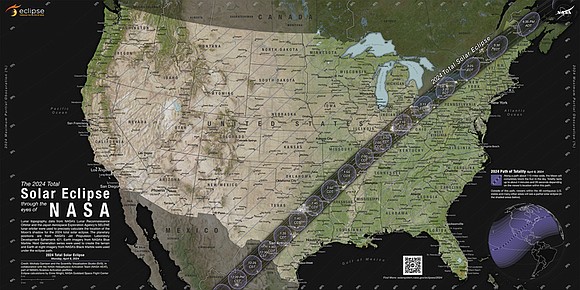Schools prepare for partial solar eclipse in Richmond
Darlene M. Johnson | 4/4/2024, 6 p.m.

It all happens Monday, April 8 when a total solar eclipse will span across the U.S., Mexico and Canada as the Moon passes between the Earth and the Sun, blocking sunlight.
Virginia is not one of the many states that will be in the path of totality to see the total solar eclipse. But Richmond will see a partial solar eclipse with about 86% of the Sun covered by the Moon, according to Dr. Robert Gowdy, an astronomy professor and associate chair of the Department of Physics at Virginia Commonwealth University.
In Richmond, the partial eclipse will begin around 2 p.m. and reach peak coverage around 3 p.m., Dr. Gowdy said.
The partial eclipse will end around 4:30 p.m.
A partial solar eclipse is just as dangerous as a total solar eclipse.
During a solar eclipse, the total amount of light entering the eye may not be enough to trigger the eyes’ reflexes that prevent looking directly at the Sun, Dr. Gowdy said. However, the amount of light focused on the eyes’ light
detecting cells can be the same as full, direct sunlight that can lead to the cells being burned out.
“The cells most likely to be affected are at the center of the field of vision,” Dr. Gowdy said. “Those cells do not grow back, so the damage is permanent.”
To view the solar eclipse, approved eclipse glasses must be used, not sunglasses. Dr. Gowdy also suggests viewing the solar eclipse on TV or building an eclipse viewer with a pinhole to make an image of the Sun.
As a precaution, schools in the greater Richmond area have made changes to schedules for Monday, April 8.
Richmond Public Schools will delay dismissal by 10 minutes for all middle and high schools. Any classes without proper eye protection will remain indoors after 2 p.m.
Henrico County Public Schools will move physical education classes and other activities indoors during the eclipse. All middle school dismissals will be delayed by 10 minutes.
Chesterfield County Public Schools will dismiss students three hours and 15 minutes early, and all after-school activities are canceled.
Petersburg City Public Schools will dismiss students from Petersburg High School and Pittman Academy at 11 a.m. Vernon Johns Middle School and Blandford Academy will be released at 11:30 a.m., all elementary schools will be released at noon and Westview Early Childhood Education Center will be released at 12:30 p.m.
Colonial Heights Public Schools and Hopewell City Public Schools’ schedules will remain the same, but students will be provided with protective glasses. Hanover County Public Schools has not made any schedule changes and will inform students of the dangers of looking at the partial solar eclipse.
Total solar eclipses occur somewhere on Earth around every 18 months. Many are not visible since much of the Earth is covered with water and deserts, Dr. Gowdy said.
Astronomers use Isaac Newton’s Law of Gravity and Laws of Motion to predict the exact paths of the Earth around the Sun and the Moon around the Earth to know when solar eclipses will occur. Solar eclipses repeat on a regular cycle called the Saros Cycle that lasts eight years, 11 days and eight hours, he said.
The upcoming solar eclipse will differ from the last one in August of 2017.
“In the path of totality, the total eclipse will last about four and a half minutes,” Dr. Gowdy said. “That is unusually long because this eclipse is happening when the Moon is at its closest approach to Earth.”
The longest period of totality during the 2017 solar eclipse was in Illinois at almost three minutes long, according to NASA.
The upcoming solar eclipse will also have a wider path over North America. While the path was between 62-71 miles wide in 2017, this year’s solar eclipse will be between 108-122 miles wide, according to NASA.
The next solar eclipse will be on Aug. 23, 2044, according to NASA. For more information, please visit www.science.nasa.gov/eclipses/future-eclipses/eclipse-2024.






